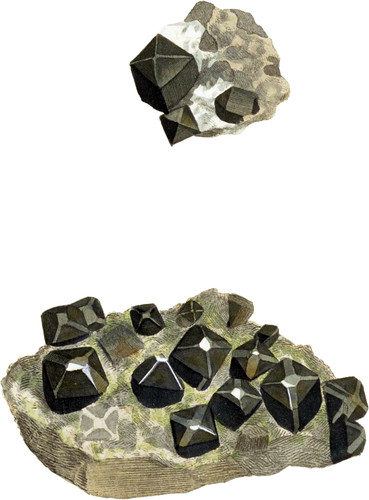 Enlarge
Enlarge
British Mineralogy
Oxygenized Tin
- Class 3. Metals.
- Ord. 1. Ductile.
- Gen. 8. Tin.
- Spec. 2. Native oxide.
- Div. 1. Crystallized.
- Gen. Char. Nearly as white as silver, malleable, ductile, and sonorous in a small degree, flexible, but with a crackling noise. Spec. grav. only 7.063 to 7.331. Smell unpleasant. Fuses at 410° Fahrenh. Not soluble in nitric acid.
- Spec. Char. Tin united with oxygen.
- Syn.
- Common tin stone. Kir. v. 2. 197.
- Zinnstein. Emmerling, v. 2. 421.
- Etain oxydé. Haüy, v. 4. 137.
- Stannum crystallinum. Linn. Syst. ed. 12, v. 3. 130.
Tin, although universally known in the metallic state as obtained from its ore, would never be recognizable without experience in the crystallized oxide, from which it is chiefly procured. This crystal was once thought, by the Cornish miners, to be destitute of metal. The tin mines of Cornwall are the most famous in the world, and were very early known. The Phœnicians procured this metal from thence.
The Cornish tin ores are said to be the most pure, as they contain less iron and arsenic than those of Bohemia, Saxony, &c. The crystals are mostly confused: specimens however are sometimes found (and preserved to gratify the curious) which are very distinct and beautiful. They resemble bottle glass; are mostly of a black hue, approaching a brownish horny lustre; sometimes brighter, and with a fiery sparkling, varying to red, gray, or whitish. The crystals are cubic or octaëdral modifications: the perfect cube has never, I believe, been found. The octaëdron, I am told, is perfect in the Honourable Mr. Greville’s collection. I have one nearly so. They often press against each other, forming macles, &c. This ore is found varying, sometimes amorphous, in the quartzose, decayed granite, or growan, killas, or other rocks: also in streams, and is then called stream tin. It occurs also in pebbles, and sandy particles. A rare variety, called wood tin, or tin hæmatites; and sulphuret of tin, are found in different parts of Cornwall. There is very little tin in Devonshire, and none in any other county of Great Britain.

